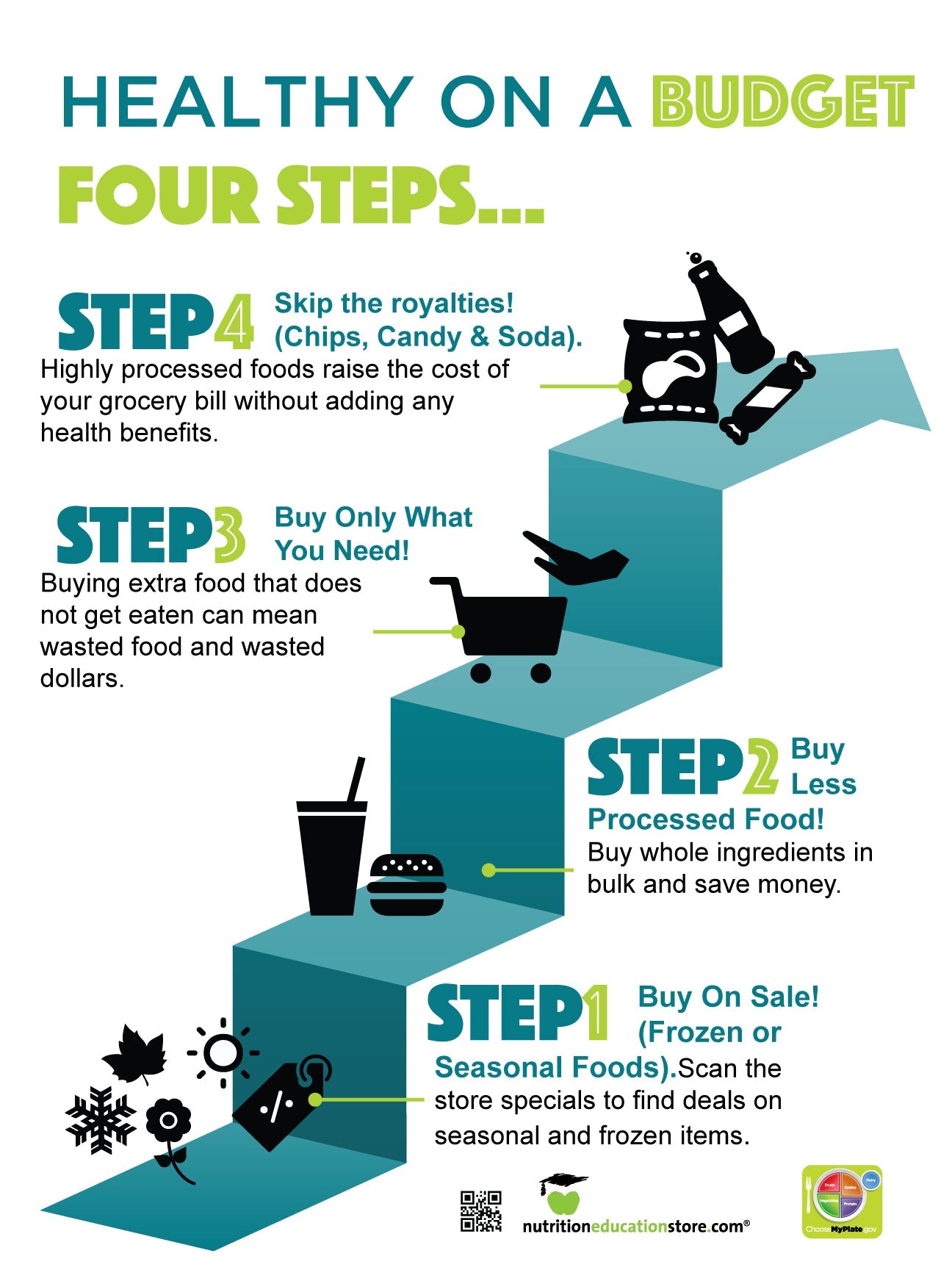As I mentioned in last week’s blog, the U.S. Department of Agriculture (USDA) recently released Actions on Nutrition Security, a report on the agency’s commitment to ensuring both nutrition security and food security to support optimal health and well-being for all Americans.
- Food security is having enough calories.
- Nutrition security is having the right calories.
Healthy Eating on a Budget Poster
Our Healthy Eating on a Budget poster conveys a simple, yet effective, four-step approach to help your students, employees, or clients make healthy, budget-conscious decisions at the supermarket.
- Step 1: Buy on sale and in season
- Step 2: Buy less processed food
- Step 3: Buy only what you need, avoid food waste
- Step 4: Skip the royalties (high fat/high sugar foods and beverages, like chips, candy, and soda)
Go a step further by combining the Healthy Eating on a Budget poster with USDA’s free Shop Simple with MyPlate mobile or desktop app.
- Create an eye-catching and informative bulletin board. Put the Healthy Eating on a Budget poster in the middle, surrounded with color printouts of key screenshots from the app, OR
- Hold a lunch-and-learn session to introduce the four steps to eating healthy on a budget. Use the Shop Simple with MyPlate app to engage your audience in real-life scenarios.
Using MyPlate App with Healthy Eating on a Budget steps
- How to find seasonal fresh produce or the most affordable canned/frozen fruits and veggies using the Shop Simple with MyPlate app:
- Click on Ways to Save -> Shop Smart -> Fruits and Vegetables. From here you’ll find a link to the Seasonal Produce Guide from SNAP-Ed Connection, as well as tips on choosing canned and frozen fruits and veggies.
- You can also Browse Budget-Friendly Fruits and Browse Budget-Friendly Vegetables.
- To locate the nearest farmers market, click on Farmers Markets in your area. Enter your zip code, then click on Find Farmers Markets. You’ll get a list of farmers markets in the area. Click on the market to get directions.
- How to choose less-processed protein foods when meat, poultry, and fish prices are so high, using the Shop Simple with MyPlate app:
- Click on Browse by MyPlate Food Groups -> Protein Foods. You’ll find a list of budget-friendly protein foods, along with tips, serving ideas, recipes, and nutrition information.
- For example, under chicken drumsticks or thighs, there’s information on freezing chicken when it’s on sale, and how to make baked chicken nuggets at home.
- Click on Browse by MyPlate Food Groups -> Protein Foods. You’ll find a list of budget-friendly protein foods, along with tips, serving ideas, recipes, and nutrition information.
- How to cut down on food waste using the Shop Simple with MyPlate app:
- For each budget-friendly food, the app gives tips that can help limit food waste.
- For example, the app tells you how long milk stays fresh after opening, and how to freeze and thaw milk. It also provides ideas on how to use up foods that are about to go bad or are over-ripe.
- For each budget-friendly food, the app gives tips that can help limit food waste.
- How to avoid impulse purchases of junk food using the Shop Simple with MyPlate app: Even when junk food isn’t on your shopping list, it can end up in your cart when you shop while hungry or give in to a screaming child. One way to deal with this is to order online for curbside pickup.
- Not all grocery stores accept SNAP/EBT for online orders, but the Shop Simple with MyPlate app can help you find ones that do.
- On the home page, click on SNAP EBT Savings. Enter your zip code and click Find Stores. Choose Online SNAP Stores. Click on the name of the store and you’ll be directed to the retailer’s website page that explains how to use your SNAP/EBT card for online orders.
- Not all grocery stores accept SNAP/EBT for online orders, but the Shop Simple with MyPlate app can help you find ones that do.
Did you know?
One final tip: You can use SNAP benefits to purchase fresh herbs for cooking, as well as fruit, vegetable, and herb plants for gardening.
By Hollis Bass, MEd, RD, LD





